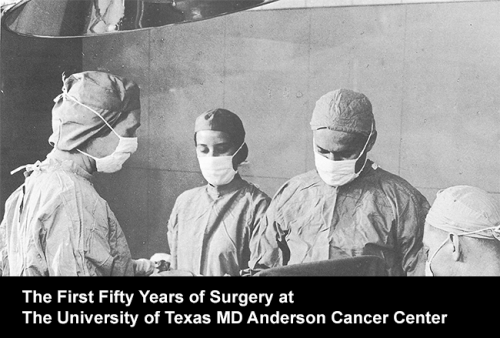

Chapter 04: The Evolution of the Head & Neck Surgery Department at MD Anderson, and the Evolving Field of Head & Neck Surgery
Files
Description
Dr. Byers reviews factors leading to his promotion to Assistant Professor in 1972, the growth of the Head & Neck Surgery department at MD Anderson, and touches on different perspectives of the evolving practitioner roles within the field of head & neck surgery.
Identifier
ByersR_01_2019014_C04
Publication Date
10-14-2019
Publisher
The Historical Resources Center, The Research Medical Library, The University of Texas MD Anderson Cancer Center
City
Houston, Texas
Interview Session
Topics Covered
The Univeristy of Texas MD Anderson Cancer Center - Building the InstitutionProfessional Path; Building/Transforming the Institution; Controversies; Global Issues – Cancer, Health, Medicine
Creative Commons License

This work is licensed under a Creative Commons Attribution-Noncommercial-No Derivative Works 3.0 License.
Disciplines
History of Science, Technology, and Medicine | Oncology | Oral History | Surgery
Transcript
Charles Balch, MD
And I think as you and I talked about, Bill MacComb’s legacy is going to be in his national leadership role in the Ewing Society, the American Radium Society, and the Society of Head and Neck Surgery, for which he was president of all of those, and that was his legacy of what he contributed. I think the other thing as I’ve watched this from the outside is the evolution of head and neck surgery from general surgeons operating around the lips and the skin and the neck to then going deeper when there was rehabilitation and reconstructive surgery.
Robert Byers, MD
That started before that.
Charles Balch, MD
And technical expertise to do the squamous cell cancers. And Hayes Martin was—
Robert Byers, MD
Way before that, Charles. The Head and Neck Department was very weak in its plastic. When Marga Sinclair was the only plastic surgeon we had. And we had outside, not too much either. ENT were doing some bad stuff we thought. They weren’t competitive, except they were trained above the clavicles. So we were doing a lot of really aggressive surgery. The same that Memorial was doing.
Charles Balch, MD
And this was a one-year fellowship in head and neck surgery?
Robert Byers, MD
It was one-year fellowship, but Ballantyne had a heart attack and was out of commission. And Jesse said, “Byers, I don’t have to recruit another staff man, I’m promoting you to the faculty as assistant professor.” So I entered.
Charles Balch, MD
And what year was that? What year was that?
Robert Byers, MD
Let’s see, I was a senior surgeon in head and neck in ’71, that was one year after my—that was that quasi fellowship. Then when Ballantyne had his thing in 1972 I was appointed assistant surgeon and assistant professor in head and neck.
Charles Balch, MD
And then who else was on the faculty at that time besides Bill MacComb and Dick Jesse?
Robert Byers, MD
There was John Bardwil, there was MacComb, there was Ballantyne of course, Jesse.
Charles Balch, MD
Oscar Guillamondegui came later.
Robert Byers, MD
Oscar Guillamondegui was on the service.
Charles Balch, MD
He was also at the same time.
Robert Byers, MD
Yeah. And so that became the nidus of the head and neck section.
Charles Balch, MD
Then do you recall what year Helmuth Goepfert came to train?
Robert Byers, MD
Goepfert started out in 1964 at UCLA, came from Chile in 1966, a researcher and fellow in surgery at MD Anderson, went back to Chile in 1968, stayed in Chile for two years, then went to Germany in 1970, 1971 through ’74 he came to Houston and had to take a residency in ENT because he didn’t have the training to get his boards in general surgery. Then 1979 on the faculty. I don’t think he’s ever had his boards in general surgery, maybe he has, I don’t know. But then in 1979 he came on the faculty of head and neck.
Charles Balch, MD
So he came later in the ’70s. So in the beginning really it was Dick Jesse, you, Oscar.
Robert Byers, MD
Oscar and Bardwil and MacComb as I say.
Charles Balch, MD
Exactly. And there was a one-year fellowship.
`
Robert Byers, MD
We started a one-year fellowship with a guy named Jim Suen who came from Arkansas.
Charles Balch, MD
Was at Arkansas, yes, who’s still there.
Robert Byers, MD
And he later went back to become the chairman at the University of Arkansas. And then we started a fellowship for one year in general surgery, which would have a rotation in head and neck. Then it became we’d have our own fellowship in head and neck. And we tried to take mostly general surgeons, but the field was changing rapidly, and I gave my presidential address in Toronto saying, “We’ve got to realize the reality of this.” And general surgery will have to either become ENTers, or ENTs will have to become good enough to do it, and we got to just accept the—I probably could have been president of the SSO if I hadn’t taken that position. Jesse said, maybe one of his addresses, I don’t know exactly when, but mirrored that same philosophy. And I just espoused it in Toronto as president of head and neck. And I would say if I’d played the politics right, I could have been the president of—I was president of the Radium Society, so I had the same, MacComb, I was sitting with two feet, one feet in the radiotherapy, one feet in head.
Recommended Citation
Byers, Robert MD; Rosolowski, Tacey A. PhD; and Balch, Charles M. MD, "Chapter 04: The Evolution of the Head & Neck Surgery Department at MD Anderson, and the Evolving Field of Head & Neck Surgery" (2019). History of Surgery - Interview Chapters. 15.
https://openworks.mdanderson.org/surgeryhist_interviewchapters/15
Conditions Governing Access
Open



